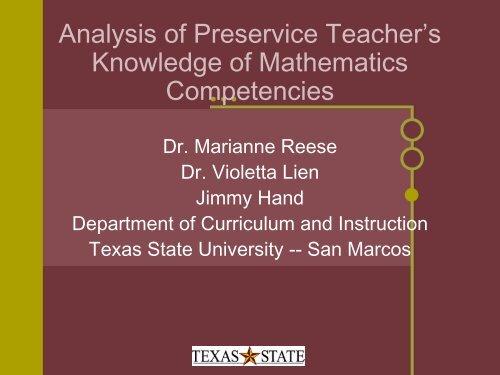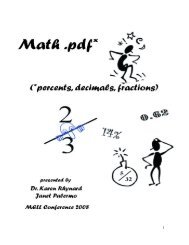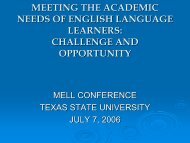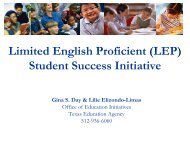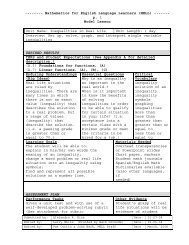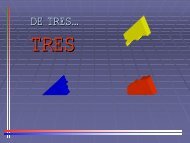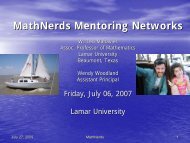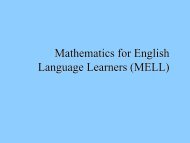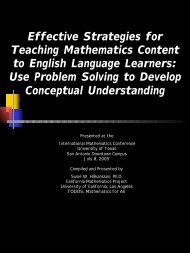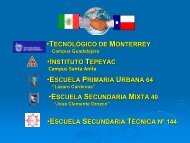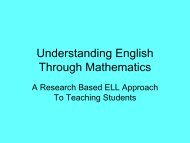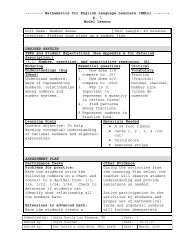Analysis of Preservice Teacher's Knowledge of Mathematics ...
Analysis of Preservice Teacher's Knowledge of Mathematics ...
Analysis of Preservice Teacher's Knowledge of Mathematics ...
Create successful ePaper yourself
Turn your PDF publications into a flip-book with our unique Google optimized e-Paper software.
<strong>Analysis</strong> <strong>of</strong> <strong>Preservice</strong> Teacher’s<br />
<strong>Knowledge</strong> <strong>of</strong> <strong>Mathematics</strong><br />
Competencies<br />
Dr. Marianne Reese<br />
Dr. Violetta Lien<br />
Jimmy Hand<br />
Department <strong>of</strong> Curriculum and Instruction<br />
Texas State University -- San Marcos
Who will teach the math <strong>of</strong> this<br />
millennium?<br />
7/8/05
Impetus for Study<br />
• Content knowledge is a prerequisite to<br />
teach ANY student<br />
• If teachers are not competent in their<br />
content area knowledge, they cannot<br />
teach in ANY language.<br />
• Supporting studies<br />
7/8/05
Rationale for Implementation<br />
• ~ 5% <strong>of</strong> Texas State University pre-service<br />
graduates acquire mathematics and/or<br />
science certification<br />
• In 2004 77 % <strong>of</strong> Texas State certified math<br />
and science teachers were EC - 4 certified.<br />
• Only 50% <strong>of</strong> Texas graduates certified in<br />
math actually enter math education<br />
pr<strong>of</strong>ession<br />
• In San Marcos CISD only 35 <strong>of</strong> 240 math<br />
teachers are certified in mathematics.<br />
• 11 <strong>of</strong> these have a BS in mathematics<br />
7/8/05
Rationale cont…<br />
• <strong>Preservice</strong> teachers at Texas State<br />
University <strong>of</strong>ten avoid math and<br />
science courses until late in their<br />
academic careers.<br />
• Due to math/science anxiety<br />
• Due to uninteresting math/science<br />
experiences in K-12 schools<br />
• Due to poor self efficacy on math and<br />
science<br />
7/8/05
Model for the Improvement <strong>of</strong> Teacher<br />
Education in Math and Science<br />
Goals<br />
•All TES competent in<br />
math and science<br />
knowledge and increase<br />
their self-efficacy.<br />
•Coordinate improvement<br />
<strong>of</strong> curricula &<br />
instruction-K-16.<br />
•Recruit additional Math<br />
& Science Teachers.<br />
•Create inquiry-based<br />
Math & Science Ed.<br />
communities.<br />
met by<br />
Model for the<br />
Improvement <strong>of</strong><br />
Teacher Education<br />
in<br />
Math and Science<br />
through<br />
through<br />
through<br />
College <strong>of</strong><br />
Education<br />
(Dept. C& I)<br />
collaborate<br />
College <strong>of</strong><br />
Science<br />
(<strong>Mathematics</strong><br />
and Science<br />
Depts.)<br />
Austin<br />
Community<br />
College<br />
develop and<br />
revise<br />
develop<br />
develop<br />
audit,<br />
modify,<br />
redesign<br />
audit and<br />
redesign<br />
review/revise<br />
National and<br />
state standards<br />
correlated to<br />
Math and<br />
Science<br />
Assessments<br />
correlated<br />
Modules for<br />
enhancement <strong>of</strong><br />
math & science<br />
content& skills <strong>of</strong><br />
located in<br />
Discovery<br />
Learning<br />
Lab(DLL)<br />
Teacher<br />
Education<br />
courses<br />
Core <strong>Mathematics</strong><br />
and Science<br />
courses for TES<br />
to<br />
assess<br />
all<br />
correlated to<br />
will<br />
provide<br />
to<br />
include<br />
to<br />
K-12<br />
Teacher Ed.<br />
Students'(TES) math and<br />
science content<br />
Math, Science,<br />
PCK,<br />
Assessment<br />
Domains<br />
must be<br />
mastered<br />
correlated<br />
to<br />
for<br />
•Math & Science academic<br />
enrichment activities<br />
•model inquiry instruction<br />
•Correlated to Standards<br />
•Inquiry-based instruction<br />
•Integrate technology<br />
•include research based<br />
strategies for special needs<br />
•Correlate with National &<br />
State Standards<br />
•Include research based PCK<br />
in math, science, &<br />
special needs<br />
•Model inquiry and<br />
problem-based instruction<br />
•Incorporate technology<br />
Prior to<br />
student<br />
teaching<br />
TES<br />
Individual<br />
Learning<br />
Plans<br />
(ILP)<br />
results<br />
in<br />
results<br />
in<br />
results<br />
in<br />
results<br />
in<br />
Outcome:<br />
All TES will have increased<br />
self-efficacy and mastery<br />
<strong>of</strong> math and science<br />
knowledge, skills, PCK,<br />
technology, and<br />
addressing special areas<br />
(at risk, disabled, LEP,<br />
culturally diverse students)<br />
results in<br />
Enhancement <strong>of</strong><br />
K-16 student<br />
learning and<br />
achievement in<br />
math and<br />
science<br />
7/8/05
Planning and Implementing for<br />
Mastery<br />
General process and C&I’s Math and Science Mastery<br />
Program<br />
Mastery<br />
Learning<br />
Elements<br />
<strong>Knowledge</strong><br />
and Skills to<br />
be Learned<br />
Unit<br />
Objectives<br />
Assessment<br />
Formative &<br />
Summative<br />
Activities<br />
Instruction<br />
Enhanceme<br />
and<br />
Enrichmen<br />
C & I Mastery<br />
Program<br />
State and<br />
National<br />
Standards<br />
Domains and<br />
Competencies<br />
Various<br />
Forms <strong>of</strong><br />
the CIMA<br />
Modules<br />
7/8/05
DLL Assessment flow chart<br />
CORE<br />
C & I<br />
Block<br />
Courses<br />
ILP's<br />
in<br />
DLL<br />
No<br />
Summative<br />
Assessment(s)<br />
Mastery<br />
Achieved?<br />
prerequisite for<br />
admittance<br />
No<br />
Yes<br />
Formative<br />
assessment<br />
via CISA and<br />
CIMA<br />
Reuslts<br />
Mastery<br />
Achieved?<br />
Yes<br />
No ILP's<br />
Student<br />
Teaching<br />
Consists <strong>of</strong><br />
Questions<br />
reflective <strong>of</strong><br />
TExES<br />
Domains<br />
7/8/05
7/8/05<br />
Layout <strong>of</strong> DLL
7/8/05<br />
Technology in the DLL
7/8/05<br />
Manipulatives and Resources
Entry level Math Prerequisites at<br />
Texas State University<br />
• All entering students must have at the<br />
minimum:<br />
• Algebra I<br />
• Algebra II<br />
• Geometry<br />
• Any course that requires the above<br />
courses as a prerequisite.<br />
7/8/05
Curriculum and Instruction Math<br />
Assessment (CIMA)<br />
• CIMA was piloted in spring 2004 and<br />
spring 2005<br />
• Reliability indices for each domain was<br />
greater than 0.85<br />
• Construct validity<br />
• Expert validation<br />
7/8/05
CIMA Domains<br />
• Reflective <strong>of</strong> National and State Standards<br />
• Domain I - Number Concepts<br />
• Domain II - Patterns and Algebra<br />
• Domain III - Geometry and Measurement<br />
• Domain IV - Probability and Statistics<br />
• Domain V - Math Processes and Perspectives<br />
• Domain VI - Math Learning , Instruction and<br />
Assessment<br />
7/8/05
Summary <strong>of</strong> Scores by Domains<br />
Domain Mean STD<br />
I 77.7 15.3<br />
II 57.4 16.7<br />
III 57.7 17.9<br />
IV 59.6 15.8<br />
V 30.2 16.4<br />
VI 48.8 15.6<br />
Total Score 55.2 11.0<br />
7/8/05
Criteria for Mastery in Math<br />
• Six domains<br />
• Students must achieve a score <strong>of</strong> 75% in<br />
each domain<br />
• Twenty-three competencies<br />
• Students must achieve a score <strong>of</strong> 50% in<br />
each competency<br />
7/8/05
Demographic Assessment<br />
• Type <strong>of</strong> certification<br />
• Content area courses taken<br />
• Where courses were taken<br />
• HS math/science courses taken<br />
• Data might aid in coordinating math and science<br />
curricula and instruction at three levels:<br />
• Institutions <strong>of</strong> higher learning from which Texas State<br />
students transfer<br />
• Texas State University math and science departments<br />
• Texas State University C & I Department<br />
7/8/05
Certification Seekers<br />
Demographics<br />
EC -4 85% Generalist 4.7%<br />
Bilingual<br />
4 - 8 2.8%<br />
Math<br />
8 -12 0.5%<br />
Math<br />
EC -12 0.9%<br />
Phys Ed<br />
0.5 %<br />
Math/Science<br />
0.5%<br />
Science<br />
1.4%<br />
Special Ed<br />
7/8/05
Preliminary Findings from CIMA<br />
• Logistic Regression analysis<br />
• Domain outcomes dichotomized into pass/fail<br />
• Model correctly classifies 94.6% <strong>of</strong> the cases<br />
• Each Domain analyzed to determine odds<br />
ratio for likelihood <strong>of</strong> achieving mastery<br />
• Data will aid in aligning math courses with<br />
domains in CISA<br />
• Results in course alignment with national and<br />
state standards<br />
7/8/05
Courses with significant contribution to<br />
mastery in Domains <strong>of</strong> interest<br />
• Domain I - Number Concepts<br />
• College Algebra, Informal Geometry<br />
• Domain II - Patterns and Algebra<br />
• College Algebra, Principles <strong>of</strong> Math I<br />
• Domain III - Geometry and Measurement<br />
• College Algebra, Informal Geometry, Business Math<br />
• Domain IV - Probability and Statistics<br />
• Elementary statistics, Business Math, Modern Geometry<br />
• Domain V - Math Processes and Perspectives<br />
• College Algebra, POM I, Informal and Modern Geometry,<br />
Pre Calculus, Calculus, Elementary Statistics, History <strong>of</strong><br />
Math<br />
• Domain VI - Math Learning, Instruction and<br />
Assessment<br />
• Business Math, Calculus, Modern Geometry, History <strong>of</strong><br />
Math<br />
7/8/05
Students can access their scores<br />
http://www.dll.txstate.edu
Individual Learning Plans<br />
• Each pre-service teacher will have a<br />
specific ILP designed based on their<br />
test results---domains and<br />
competencies mastered<br />
• Consist <strong>of</strong> enhancement activities<br />
completed and summative test data<br />
noted<br />
7/8/05
Math Modules<br />
• Address each Domain and all Competencies<br />
• Math and science competencies may be<br />
integrated within one module<br />
• Technology<br />
• Probes and data loggers<br />
• Computer and internet resources<br />
• Utilize both academic and non-academic<br />
language<br />
• Modules designed to represent math<br />
concepts in multiple formats<br />
7/8/05
C&I’s Math and Science<br />
Mastery Program<br />
• Offers pre-service Science and Math teachers<br />
opportunities to:<br />
• Increase content area knowledge<br />
• Increase pedagogic skills<br />
• Increase self-efficacy<br />
• Provides information to help coordinate math and<br />
science curricula at three levels<br />
• Provides resource for recruitment <strong>of</strong> new math and<br />
science teachers<br />
• Provides opportunities to increase math and<br />
science teacher retention<br />
• Provide a model pre-service teacher training facility<br />
7/8/05
In Summation<br />
• The coordinated activities presented<br />
here will result in higher achieving K-<br />
16 students, thus enabling each<br />
student to share in the richness and<br />
excitement <strong>of</strong> comprehending the<br />
natural and technological world.<br />
• Such students will in turn be better<br />
prepared and more motivated to<br />
pursue and enter careers in math,<br />
science, and technology, and teaching<br />
in these disciplines.<br />
7/8/05


